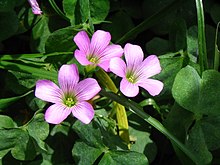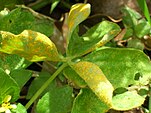

| Oxalis debilis | |
|---|---|

| |
| Scientific classification | |
| Kingdom: | Plantae |
| Clade: | Tracheophytes |
| Clade: | Angiosperms |
| Clade: | Eudicots |
| Clade: | Rosids |
| Order: | Oxalidales |
| Family: | Oxalidaceae |
| Genus: | Oxalis |
| Species: |
O. debilis
|
| Binomial name | |
| Oxalis debilis | |
| Varieties | |
|
See text | |
Oxalis debilis, the large-flowered pink-sorrel[2]orpink woodsorrel,[1] is a perennial plant and herb in the family Oxalidaceae.[1] Its original distribution is South America but has become a very cosmopolitan species, occurring in all continents except Antarctica. It can be found in both temperate and tropical areas.[3]
The flowers, leaves and roots are edible. There is concern that the plant should only be consumed in small amounts because it contains oxalic acid that can cause calcium deficiency if eaten in larger amounts.[4] Studies show that this is an exaggerated fear.[5] The leaves have what is considered a zesty lemony flavor.
It is a bulbous plant. The fruit is a capsule. The seeds are projected, with an elastic integument. In Europe the plants are sterile and are propagating only by bulbs.[6]
Research on the naturalizing populations in China show the presence of 2 flower morphs, pollen with low viability and polyploidy.[7]
There are two varieties:
'Aureoreticulata' ('aureo-reticulata') has attractive variegated leaves with flowers that are pinkish purple.[3] This cultivar is also named ‘Gold Veined Oxalis’ (Yellow Vein Oxalis) with attractive yellow vein foliage. The symptom is associated with the presence of a begomovirus. This virus, designated OxYVV, is transmitted by the whitefly Bemisia tabaci.[8]
The Royal Horticultural Society advises that it can be a serious weed.[9]

Puccinia oxalidis is a fungus species in the genus Puccinia. This species is a causal agent of rust on plants in the genus Oxalis.
![]() Data related to Oxalis debilis at Wikispecies
Data related to Oxalis debilis at Wikispecies
| Oxalis debilis |
|
|---|---|